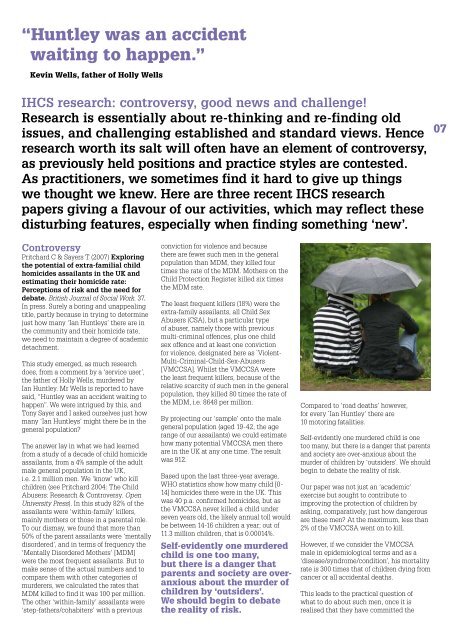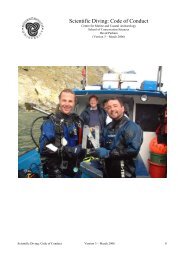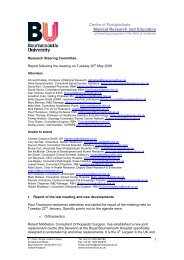Issue 9 (PDF 1.26 mb) - Bournemouth University
Issue 9 (PDF 1.26 mb) - Bournemouth University
Issue 9 (PDF 1.26 mb) - Bournemouth University
You also want an ePaper? Increase the reach of your titles
YUMPU automatically turns print PDFs into web optimized ePapers that Google loves.
“Huntley was an accident<br />
waiting to happen.”<br />
Kevin Wells, father of Holly Wells<br />
IHCS research: controversy, good news and challenge!<br />
Research is essentially about re-thinking and re-finding old<br />
issues, and challenging established and standard views. Hence<br />
research worth its salt will often have an element of controversy,<br />
as previously held positions and practice styles are contested.<br />
As practitioners, we sometimes find it hard to give up things<br />
we thought we knew. Here are three recent IHCS research<br />
papers giving a flavour of our activities, which may reflect these<br />
disturbing features, especially when finding something ‘new’.<br />
Controversy<br />
Pritchard C & Sayers T (2007) Exploring<br />
the potential of extra-familial child<br />
homicides assailants in the UK and<br />
estimating their homicide rate:<br />
Perceptions of risk and the need for<br />
debate. British Journal of Social Work. 37.<br />
In press. Surely a boring and unappealing<br />
title, partly because in trying to determine<br />
just how many ‘Ian Huntleys’ there are in<br />
the community and their homicide rate,<br />
we need to maintain a degree of academic<br />
detachment.<br />
This study emerged, as much research<br />
does, from a comment by a ‘service user’,<br />
the father of Holly Wells, murdered by<br />
Ian Huntley. Mr Wells is reported to have<br />
said, “Huntley was an accident waiting to<br />
happen”. We were intrigued by this, and<br />
Tony Sayer and I asked ourselves just how<br />
many ‘Ian Huntleys’ might there be in the<br />
general population?<br />
The answer lay in what we had learned<br />
from a study of a decade of child homicide<br />
assailants, from a 4% sample of the adult<br />
male general population in the UK,<br />
i.e. 2.1 million men. We 'know’ who kill<br />
children (see Pritchard 2004: The Child<br />
Abusers: Research & Controversy. Open<br />
<strong>University</strong> Press). In this study 82% of the<br />
assailants were ‘within-family’ killers,<br />
mainly mothers or those in a parental role.<br />
To our dismay, we found that more than<br />
50% of the parent assailants were ‘mentally<br />
disordered’, and in terms of frequency the<br />
‘Mentally Disordered Mothers’ [MDM]<br />
were the most frequent assailants. But to<br />
make sense of the actual nu<strong>mb</strong>ers and to<br />
compare them with other categories of<br />
murderers, we calculated the rates that<br />
MDM killed to find it was 100 per million.<br />
The other ‘within-family’ assailants were<br />
‘step-fathers/cohabiters’ with a previous<br />
conviction for violence and because<br />
there are fewer such men in the general<br />
population than MDM, they killed four<br />
times the rate of the MDM. Mothers on the<br />
Child Protection Register killed six times<br />
the MDM rate.<br />
The least frequent killers (18%) were the<br />
extra-family assailants, all Child Sex<br />
Abusers (CSA), but a particular type<br />
of abuser, namely those with previous<br />
multi-criminal offences, plus one child<br />
sex offence and at least one conviction<br />
for violence, designated here as `Violent-<br />
Multi-Criminal-Child-Sex-Abusers<br />
[VMCCSA]. Whilst the VMCCSA were<br />
the least frequent killers, because of the<br />
relative scarcity of such men in the general<br />
population, they killed 80 times the rate of<br />
the MDM, i.e. 8648 per million.<br />
By projecting our ‘sample’ onto the male<br />
general population (aged 19-42, the age<br />
range of our assailants) we could estimate<br />
how many potential VMCCSA men there<br />
are in the UK at any one time. The result<br />
was 912.<br />
Based upon the last three-year average,<br />
WHO statistics show how many child [0-<br />
14] homicides there were in the UK. This<br />
was 40 p.a. confirmed homicides, but as<br />
the VMCCSA never killed a child under<br />
seven years old, the likely annual toll would<br />
be between 14-16 children a year; out of<br />
11.3 million children, that is 0.00014%.<br />
Self-evidently one murdered<br />
child is one too many,<br />
but there is a danger that<br />
parents and society are overanxious<br />
about the murder of<br />
children by ‘outsiders’.<br />
We should begin to debate<br />
the reality of risk.<br />
Compared to ‘road deaths’ however,<br />
for every `Ian Huntley’ there are<br />
10 motoring fatalities.<br />
Self-evidently one murdered child is one<br />
too many, but there is a danger that parents<br />
and society are over-anxious about the<br />
murder of children by ‘outsiders’. We should<br />
begin to debate the reality of risk.<br />
Our paper was not just an ‘academic’<br />
exercise but sought to contribute to<br />
improving the protection of children by<br />
asking, comparatively, just how dangerous<br />
are these men? At the maximum, less than<br />
2% of the VMCCSA went on to kill.<br />
However, if we consider the VMCCSA<br />
male in epidemiological terms and as a<br />
‘disease/syndrome/condition’, his mortality<br />
rate is 300 times that of children dying from<br />
cancer or all accidental deaths.<br />
This leads to the practical question of<br />
what to do about such men, once it is<br />
realised that they have committed the<br />
07










